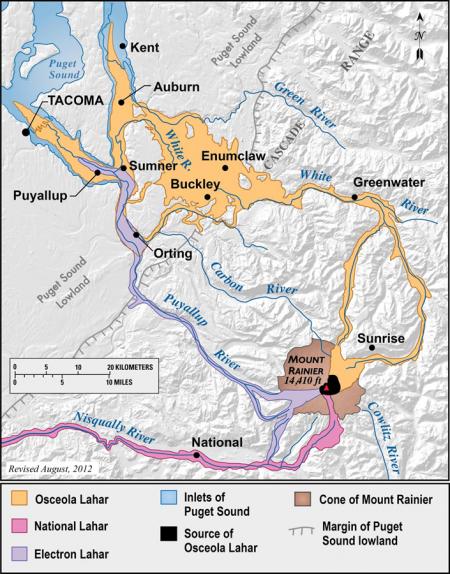15.3 Preventing, Delaying, Monitoring, and Mitigating Mass Wasting
We cannot prevent mass wasting, however, in many situations there are actions we can take to reduce or mitigate the damaging effects of mass wasting on people and infrastructure. Where we can neither delay nor mitigate mass wasting, we may consider trying to initiate the slope failure in a controlled manner. In areas prone to mass wasting that cannot be controlled or mitigated, we can minimize risk by not building in these areas at all.
Preventing and Delaying Mass Wasting
It is comforting to think that we can prevent some effects of mass wasting by mechanical means. For example, the rock bolts in the road cut at Porteau Cove on the Sea-toSky highway in BC (Figure 15.10) or the drill holes used to drain water out of the slope at the Downie Slide (Figure 15.9), or the building of physical barriers, such as retaining walls along highway roadcuts. These preventative measures are not permanent though, they are subject to degradation over time. The rock bolts in the road cut at Porteau Cove will slowly start to corrode after a few years, and within a few decades many of them will begin to lose their strength. Unless they are replaced, they will no longer support the slope. Likewise, drainage holes at the Downie Slide will eventually become plugged with sediment and chemical precipitates, and unless they are periodically unplugged, their effectiveness will decrease. Eventually, unless new holes are drilled, the drainage will be compromised, and the slide will start to move again. This is why careful slope monitoring by geological and geotechnical engineers is important at major mass wasting sites such as the Downie Slide and along the Sea-to-Sky highway. Our efforts to control mass wasting are only as good as our efforts to maintain the preventive measures.
Delaying mass wasting is a worthy endeavour because during the time that the measures are still effective, they can save lives and reduce damage to property and infrastructure such as homes and roads. But we must be careful to avoid activities that could make mass wasting more likely. One of the most common anthropogenic causes of mass wasting is road construction, and this applies both to remote gravel roads built for forestry and mining, and large urban and regional highways.
![Figure 15.18 An example of a road constructed by cutting into a steep slope and the use of the cut material as fill. [SE]](https://openpress.usask.ca/app/uploads/sites/29/2017/05/road-constructed-by-cutting-into-a-steep-slope.png)
Road construction is a potential problem for two reasons. First, creating a flat road surface on a slope inevitably involves creating a cut bank that is steeper than the original slope. This might also involve creating a filled bank that is both steeper and weaker than the original slope (Figure 15.18). Second, roadways typically cut across natural drainage features, and unless great care is taken to reroute the runoff water, oversaturation of slope material can occur, contributing to mass wasting.
Apart from saturation and water pressure considerations, engineers building roads and other infrastructure on bedrock slopes have to carefully consider the geology, and especially any weaknesses or discontinuities in the rock related to bedding, fracturing, or foliation. If possible, situations like that at Porteau Cove (Figure 15.10) should be avoided — by building somewhere else — rather than trying to stitch the slope back together with rock bolts.
It is widely believed that construction of buildings above steep slopes can contribute to the instability of the slope. This is likely true, but probably not because of the weight of the building. As you will determine by completing Exercise 15.3 below, a typical house is not heavier than the excavated ground that was removed to build the house. A more likely contributor to instability of the slopes below buildings is changes to the water drainage and to the saturation of the slope (by watering gardens, for example).
Exercise 15.3 How Much Does a House Weigh and Can It Contribute to Slope Failure?
It is commonly believed that building a house (or some other building) at the top of a slope will add a lot of extra weight to the slope, which could contribute to slope failure. But what does a house weigh compared to the material removed when you build it? A typical 150 m2 (approximately 1,600 ft2) wood-frame house with a basement and a concrete foundation weighs about 145 t (metric tonnes). But most houses are built on foundations that are excavated into the ground. This involves digging a hole and taking that material away, so we need to subtract what that excavated material weighs. Assuming our 150 m2 house required an excavation that was 15 m by 11 m by 1 m deep, which is 165 m3 of material. Unconsolidated sediments have densities ranging from about 0.8 to 1.7 t per m3.
For this exercise, consider a sand with a dry density of 1.2 t per m3 for this calculation. Calculate the weight of the materials that were removed and compare that with the weight of the house and its foundation.
If you are thinking that building a bigger building is going to add more weight, consider that bigger buildings need bigger and deeper excavations, and in many cases the excavations may be into solid rock, which is denser than surficial materials.
Consider how a building might change the drainage on a slope. Water can be collected by roofs, go into downspouts, and form concentrated flows that are directed onto or into the slope. Likewise, drainage from nearby access roads, lawn irrigation, leaking pools, and septic systems can all alter the surface and groundwater flow in a slope. Soil excavated from a basement.

Monitoring Mass Wasting
Warning systems are helpful in some areas where there is a risk of mass wasting. They let us know if conditions have changed at a known slide area, or if a rapid failure, such as a debris flow, is on its way downslope. The Downie Slide above the Revelstoke Reservoir is continuously-monitored with a range of devices, such as inclinometers (slope-change detectors), bore-hole motion sensors, and GPS survey instruments. A simple mechanical device for monitoring the nearby Checkerboard Slide (which is also above the Revelstoke Reservoir) is shown in Figure 15.19. Both of these slides are very slow-moving, but it is important to be able to detect changes in their rates of motion. A rapid failure would result in large bodies of rock plunging into the reservoir and sending a wall of water over the Revelstoke Dam, potentially destroying the nearby town of Revelstoke.
![Figure 15.19 Part of a motion-monitoring device at the Checkerboard Slide near Revelstoke, B.C. The lower end of the cable is attached to a block of rock that is unstable. Any incremental motion of that block will move the cable and this will be detectable on this device. [SE]](https://openpress.usask.ca/app/uploads/sites/29/2017/05/motion-monitoring-device-at-the-Checkerboard-Slide-near-Revelstoke.jpg)
Mt. Rainier, a glacier-covered volcano in Washington State (15.20), could produce massive mudflows or debris flows (lahars) with or without a volcanic eruption. Over 100,000 people in the Tacoma, Puyallup, and Sumner areas are at risk because they currently reside on deposits from past lahars and future lahars would likely also follow these paths (Figure 15.21). In 1998, a network of acoustic monitors was established around Mt. Rainier. The monitors are embedded in the ground adjacent to expected lahar paths. These monitors will provide warnings to emergency officials in the event of a lahar. When a lahar is detected, the residents of the area will have between 40 minutes and three hours to get to safe ground.


Mitigating the Impacts of Mass Wasting
In situations where we cannot predict, prevent, or delay mass-wasting hazards, some effective measures can be taken to minimize the associated risk. For example, many highways in BC and western Alberta have avalanche shelters like the one shown in Figure 15.22. In some parts of the world, similar structures have been built to protect infrastructure from other types of mass wasting.
![Figure 15.21 A snow avalanche shelter on the Coquihalla Highway. The expected path of the avalanche is the steep untreed slope above. [SE]](https://openpress.usask.ca/app/uploads/sites/29/2017/05/snow-avalanche-shelter.png)
Debris flows are inevitable, unpreventable, and unpredictable in many parts of BC, but nowhere more so than along the Sea-to-Sky Highway between Horseshoe Bay and Squamish. The results have been deadly and expensive many times in the past. It would be very expensive to develop a new route in this region, so provincial authorities have taken steps to protect residents, and traffic on the highway and railway. Debris flow defensive structures have been constructed in several drainage basins, as shown in Figure 15.23. One strategy is to allow the debris flow to flow quickly through to the ocean along a smooth channel. Another is to capture the debris within a constructed basin that allows the excess water to continue through.
![Figure 15.22 Two strategies for mitigating debris flows on the Sea-to-Sky Highway. Left: A concrete –lined channel on Alberta Creek allows debris to flow quickly through to the ocean. Right: A debris-flow catchment basin on Charles Creek. In 2010 a debris flow filled the basin to the level of the dotted white line. [SE]](https://openpress.usask.ca/app/uploads/sites/29/2017/05/mitigating-debris-flows-on-the-Sea-to-Sky-Highway-1024x313.png)
Finally, in situations where we cannot do anything to delay, predict, contain, or mitigate slope failures, the responsible and ethical thing to do is to avoid building in or using the risky area. Sometimes this may require relocating a community after discovering a previously-unidentified risk. There is a famous example of this in BC at a site known as Garibaldi, 25 km south of Whistler. In the early 1980s the village of Garibaldi had a population of about 100, with construction underway on some new homes, and plans for many more. In the months that followed the deadly 1980 eruption of Mt. St. Helens in Washington State, the BC Ministry of Transportation commissioned a geological study to assess risks along their highways. The study revealed that a steep cliff known as The Barrier (Figure 15.24) had collapsed in 1855, leading to a large rock avalanche, and that it was likely to collapse again unpredictably, putting the village of Garibaldi at extreme risk. In an ensuing court case, it was ruled that the Garibaldi site was not a safe place for people to live. Those who already had homes there were compensated, and everyone was ordered to leave.
![Figure 15.23 The Barrier, south of Whistler, B.C., was the site of a huge rock avalanche in 1855, which extended from the cliff visible here 4 km down the valley and across the current location of the Sea-to-Sky Highway and the Cheakamus River. [SE]](https://openpress.usask.ca/app/uploads/sites/29/2017/05/The-Barrier.jpg)

